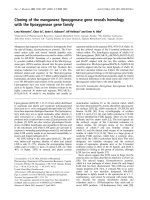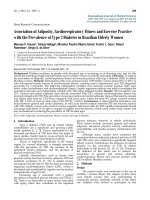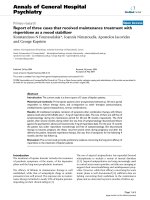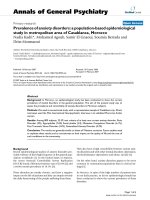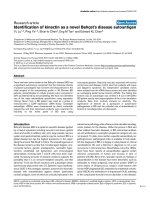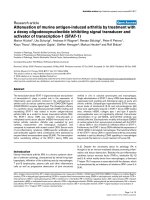Báo cáo y học: "Prediction of extubation outcome: a randomised, controlled trial with automatic tube compensation vs. pressure support ventilation" ppsx
Bạn đang xem bản rút gọn của tài liệu. Xem và tải ngay bản đầy đủ của tài liệu tại đây (203.62 KB, 7 trang )
Open Access
Available online />Page 1 of 7
(page number not for citation purposes)
Vol 13 No 1
Research
Prediction of extubation outcome: a randomised, controlled trial
with automatic tube compensation vs. pressure support
ventilation
Jonathan Cohen, Maury Shapiro, Elad Grozovski, Ben Fox, Shaul Lev and Pierre Singer
General Intensive Care Unit, Rabin Medical Center, Beilinson Campus, Petah Tikva, 49100, Israel
Corresponding author: Jonathan Cohen,
Received: 10 Sep 2008 Revisions requested: 25 Oct 2008 Revisions received: 6 Jan 2009 Accepted: 23 Feb 2009 Published: 23 Feb 2009
Critical Care 2009, 13:R21 (doi:10.1186/cc7724)
This article is online at: />© 2009 Cohen et al.; licensee BioMed Central Ltd.
This is an open access article distributed under the terms of the Creative Commons Attribution License ( />),
which permits unrestricted use, distribution, and reproduction in any medium, provided the original work is properly cited.
Abstract
Introduction Tolerance of a spontaneous breathing trial is an
evidence-based strategy to predict successful weaning from
mechanical ventilation. Some patients may not tolerate the trial
because of the respiratory load imposed by the endotracheal
tube, so varying levels of respiratory support are widely used
during the trial. Automatic tube compensation (ATC),
specifically developed to overcome the imposed work of
breathing because of artificial airways, appears ideally suited for
the weaning process. We further evaluated the use of ATC in
this setting.
Methods In a prospective study, patients who had received
mechanical ventilation for more than 24 hours and met defined
criteria for a weaning trial, underwent a one-hour spontaneous
breathing trial with either ATC (n = 87) or pressure support
ventilation (PSV; n = 93). Those tolerating the trial were
immediately extubated. The primary outcome measure was the
ability to maintain spontaneous, unassisted breathing for more
than 48 hours after extubation. In addition, we measured the
frequency/tidal volume ratio (f/VT) both with (ATC-assisted) and
without ATC (unassisted-f/VT) at the start of the breathing trial
as a pretrial predictor of extubation outcome.
Results There were no significant differences in any of the
baseline characteristics between the two groups apart from a
significantly higher Acute Physiology and Chronic Health
Evaluation (APACHE) II score in the ATC group (p = 0.009). In
the PSV group, 13 of 93 (14%) patients failed the breathing trial
compared with only 6 of 87 (6%) in the ATC group; this
observed 8% difference, however, did not reach statistical
significance (p = 0.12). The rate of reintubation was not different
between the groups (total group = 17.3%; ATC = 18.4% vs.
PSV = 12.9%, p = 0.43). The percentage of patients who
remained extubated for more than 48 hours was similar in both
groups (ATC = 74.7% vs. PSV = 73.1%; p = 0.81). This
represented a positive predictive value for PSV of 0.85 and ATC
of 0.80 (p = 0.87). Finally, the ATC-assisted f/VT was found to
have a significant contribution in predicting successful liberation
and extubation compared with the non-significant contribution
of the unassisted f/VT (unassisted f/VT, p = 0.19; ATC-assisted
f/VT, p = 0.005).
Conclusions This study confirms the usefulness of ATC during
the weaning process, being at least as effective as PSV in
predicting successful extubation outcome and significantly
improving the predictive value of the f/VT.
Trial registration Current Controlled Trials ISRCTN16080446
Introduction
Successful weaning and liberation from mechanical ventilation
remain critical stages of a patient's intensive care unit (ICU)
stay. Tolerance of a spontaneous breathing trial is an evi-
dence-based strategy to predict successful weaning from
mechanical ventilation [1]. These trials have traditionally been
performed while the patient receives varying levels of ventila-
tory support, including, in recent studies, continuous positive
airway pressure (CPAP) [2], a T-tube circuit [3] or low-level
pressure support ventilation (PSV) [4]. The level of support
may be relevant to whether the breathing trial is tolerated,
because it has been argued that, for some patients, weaning
APACHE: Acute Physiology and Chronic Health Evaluation; ATC: automatic tube compensation; CPAP: continuous positive airway pressure; FiO
2
:
fraction of inspired oxygen; f/VT: frequency to tidal volume ratio; ICU: intensive care unit; PaCO
2
: partial carbon dioxide tension in arterial blood; PaO
2
:
partial oxygen tension in arterial blood; PEEP: positive end expiratory pressure; PSV: pressure support ventilation; ROC: receiver operating curves.
Critical Care Vol 13 No 1 Cohen et al.
Page 2 of 7
(page number not for citation purposes)
failure may be attributable to the respiratory load imposed by
the endotracheal tube [5]. In support of this, Koksal and col-
leagues have demonstrated a significant increase in the endo-
crine stress response during a breathing trial [6]. The
magnitude of the response was influenced by the mode used,
being significantly greater at the end of a breathing trial with a
T-tube than with either PSV or CPAP.
Automatic tube compensation (ATC) has been developed to
overcome the imposed work of breathing due to artificial air-
ways [7]. It delivers the exact amount of pressure necessary to
overcome the resistive load of the endotracheal tube for the
flow measured at the time, without affecting the patient's
breathing pattern [8]. It potentially simulates spontaneous
breathing without the endotracheal tube, so it has been desig-
nated as 'electronic extubation' [7]. This mode of ventilation
thus seems ideally suited for use during the weaning period.
PSV was widely used in the performance of a spontaneous
breathing trial and has been shown to compensate for the
additional work of breathing imposed by the endotracheal tube
[9]. However, studies have shown that compared with PSV,
ATC was more effective in overcoming the work of breathing
necessary to overcome endotracheal tube resistance [10].
ATC was also perceived to be more comfortable by normal
volunteers [11] and resulted in less ineffective ventilator-trig-
gering as a result of auto-positive end expiratory pressure
(PEEP) [7]. However, the ventilator used in all these studies
was equipped with prototype ATC software, not available in
commercial mechanical ventilators.
It was the aim of the present prospective study to further
assess the value of ATC in predicting successful weaning. To
do this, we assessed extubation outcome after a spontaneous
breathing trial with ATC and compared it with PSV. Addition-
ally, we assessed whether the predictive value of the fre-
quency to tidal volume ratio (f/VT), widely used for predicting
successful extubation, could be enhanced by the addition of
ATC, that is, ATC-assisted f/VT.
Materials and methods
Patients
This prospective, randomised, controlled trial was approved
by the local Institutional Review Board and performed in the
12-bed general ICU of Rabin Medical Center between Octo-
ber 2006 and April 2008. Patients were eligible for enrolment
if they met the following criteria: required mechanical ventila-
tion for more than 24 hours and considered ready for weaning.
Criteria of readiness for weaning included all the following:
improvement of the cause of respiratory failure; oxygen satura-
tion of 92% or higher with a fraction of inspired oxygen (FiO
2
)
of 50% or less; stable neurological status (Glasgow Coma
Score > 8); require bronchial toilet less than twice in the eight
hours preceding the assessment; no need for vasoactive
drugs; receiving only minimal or no sedation; body tempera-
ture between 36 and 38°C; and level of pressure support of
15 cmH
2
O or less with a PEEP level of 8 cmH
2
O or less.
Measures
The following parameters were recorded before performing
the spontaneous breathing trial: demographic data, including
age, sex, admission diagnosis, admission Acute Physiology
and Chronic Health Evaluation (APACHE) II score [12], dura-
tion of mechanical ventilation and length of ICU stay; haemo-
dynamic data, including heart rate and mean arterial blood
pressure; fluid balance in the 24 hours preceding the start of
the spontaneous breathing trial; and ventilatory data, including
level of PEEP, tidal volume, partial carbon dioxide tension in
arterial blood (paCO
2
), respiratory rate, minute ventilation,
ratio of partial oxygen tension in arterial blood to fraction of
inspired oxygen (PaO
2
/FiO
2
ratio) and f/VT (breaths/minute/
L). The f/VT, assessed first with and immediately thereafter
without 100% ATC, was calculated in both groups after one
minute of spontaneous breathing with PEEP of 5 cmH
2
O and
no mandatory machine breaths supplied from the ventilator
[13]. Values were displayed on the ventilator and the value
used was the average of three breaths. At the time of measure-
ment, patients were ventilated with PSV (level 9.2 ± 1.3
cmH
2
O; mean ± standard deviation), FiO
2
less than 0.5 (mean
level 0.38 ± 0.01) and PEEP of 5 cmH
2
O. Ventilation was per-
formed with either the Evita-4 ventilator (Drager, Lubeck, Ger-
many; n = 117) or the Puritan-Bennett 840 ventilator (Puritan-
Bennett Corporation, CA, USA; n = 63) depending on the
equipment assigned to each patient bed.
Procedures
After meeting inclusion criteria, informed consent was
obtained from the patient or surrogate decision maker.
Patients were then randomly assigned, in a blinded fashion
with the use of opaque, sealed envelopes, to undergo a one-
hour spontaneous breathing trial with either ATC (patients
breathed through the ventilatory circuit using flow-triggering
and CPAP of 5 cmH
2
O, FiO
2
less than 0.5 with the addition of
ATC 100%; the ATC group) or PSV (patients breathed
through the ventilatory circuit using flow-triggering and CPAP
of 5 cmH
2
O, FiO
2
less than 0.5 with the addition of 7 cmH
2
O
of pressure support; the PSV group). These parameters were
maintained throughout the trial. Tolerance of the trial was con-
tinuously evaluated. Features of poor tolerance included: res-
piratory rate above 35 breaths/minute for five minutes or
longer, arterial saturation less than 90%, increase in heart rate
above 140 beats/minute, increase in systolic blood pressure
above 180 mmHg or decrease to less than 90 mmHg, and
increased anxiety, diaphoresis or thoraco-abdominal paradox.
For patients not tolerating the breathing trial, full ventilatory
support was reinstituted, while patients who tolerated the trial
underwent immediate extubation and received supplemental
oxygen via a face mask.
Available online />Page 3 of 7
(page number not for citation purposes)
Following extubation, reintubation was performed in the fol-
lowing conditions: hypoxaemia (oxygen saturation below 92%
for more than five minutes while receiving FiO
2
more than 0.5);
presence of respiratory acidosis (arterial pH below 7.35 with
paCO
2
above 45 mmHg); inability to protect the airway
because of upper airway obstruction (stridor); and evidence of
excessive respiratory work (respiratory rate 35 breaths/minute
of above for more than five minutes, diaphoresis or thoraco-
abdominal paradox). The reason for and time to reintubation
(rounded off to the nearest hour) were noted. The spontane-
ous breathing trial was performed by two investigators (JC and
MS). Decisions regarding reintubation were made by caregiv-
ers who were blinded to the treatment group.
Outcome variables
The primary outcome measure was successful extubation,
defined as the ability to maintain spontaneous, unassisted
breathing for longer than 48 hours after removal of the
endotracheal tube. This definition encompasses both the
number of patients tolerating the breathing trial and the
number able to maintain spontaneous breathing after extuba-
tion. In addition we assessed the value of the ATC-assisted f/
VT as compared with the unassisted-f/VT as a predictor of
successful extubation.
Statistical analyses
Differences between the ATC and PSV groups in baseline,
respiratory and haemodynamic characteristics were analysed
using Student's t-test for independent samples (for continuous
variables) and differences between groups in patient course
and outcome were analysed using the chi-squared test (for
categorical variables). Positive predictive values for PSV and
ATC with successful extubation without reintubation as the
outcome end-point were also calculated. Prediction of extuba-
tion by pretest f/VT was examined using the Student's t-test.
Receiver operating curves (ROC) were constructed for deter-
mining the prognostic accuracy of the ATC-assisted f/VT in
predicting successful liberation and extubation. In addition,
patients were divided into categories according to f/VT using
arbitrary steps of 25 breaths/minute/L. Statistical analyses
were performed using the statistical software SPSS 15.0 for
Windows (Chicago, IL, USA). Statistical results were consid-
ered significant at p < 0.05.
Results
Patient enrollment and demographics
Of the 180 patients included in the study, 87 were ran-
domised to the ATC group and 93 to the PSV group. Baseline
characteristics are shown in Table 1. There were no significant
differences at baseline between the two groups regarding
patient characteristics and indication for mechanical ventila-
Table 1
Baseline characteristics by group at start of spontaneous breathing trial
Characteristic ATC group
(n = 87)
PSV group
(n = 93)
p value
Age, years 62.1 ± 16.6 66.1 ± 18.1 0.13
Sex (male : female) 55:32 60:33 0.86
Days ventilated before SBT percentage ventilated 5.9 ± 3.5 6.3 ± 4.7 0.56
> 8 days before SBT 18.3 23 0.61
Causes of ARF 0.15
COPD exacerbation, n (%) 7 (8.1) 11 (11.8)
Pneumonia, n (%) 17 (19.5) 19 (20.5)
Sepsis with ALI, n (%) 20 (22.9) 18 (19.3)
Multi-trauma, n (%) 10 (11.5) 13 (13.9)
Post-operative, n (%) 14 (16.1) 12 (12.9)
Heart failure, n (%) 12 (13.7) 8 (8.6)
Other, n (%) 7 (8.2) 12 (12.9)
APACHE II score 22.1 ± 7.9 19.1 ± 7.0 0.009
Endotracheal tube size, mm 7.8 ± 0.4 7.8 ± 0.4 0.73
Continuous data are presented as mean ± standard deviation. Binary data are presented as n (percentage).
ALI = acute lung injury; APACHE II = Acute Physiology and Chronic Health Evaluation II severity of illness; ARF = acute respiratory failure; ATC =
automatic tube compensation; COPD = chronic obstructive pulmonary disease; PSV = pressure support ventilation; SBT = spontaneous
breathing trial.
Critical Care Vol 13 No 1 Cohen et al.
Page 4 of 7
(page number not for citation purposes)
tion, apart from a significantly higher APACHE II score in the
ATC group (p = 0.009).
Respiratory and haemodynamic characteristics at the
start of the spontaneous breathing trial
These are shown in Table 2. There were no significant differ-
ences between the ATC and PSV groups in any of the respi-
ratory or haemodynamic parameters studied.
Patient course and outcome
These results are shown in Figure 1. In the ATC group, 81 of
87 (93%) patients tolerated the breathing trial and underwent
extubation, compared with 80 of 93 (86%) in the PSV group;
this observed 8% difference, however, was not significant (p
= 0.12). A total of 28 patients (17.3%) required reintubation:
16 (18.4%) in the ATC group and 12 (12.9%) in the PSV
group (p = 0.43). Mean time to reintubation was 16.6 hours in
the ATC group and 12.8 hours in the PSV group (p = 0.47).
Reasons for reintubation were similar in both groups and
included hypoxaemia due to inability to clear secretions (n =
16), new sepsis (n = 4), stridor (n = 2), carbon dioxide reten-
tion with altered mental status (n = 4) and diaphoresis due to
fatigue (n = 2). There was no significant difference between
the two groups in the number of patients who remained extu-
bated after 48 hours (ATC, 65 of 87 (74.7%) vs. PSV, 68 of
93 (73.1%); p = 0.81). There was no significant difference in
the positive predictive value for successful extubation
between PSV and ATC (PSV, 0.85 vs. ATC, 0.80; p = 0.87).
No significant differences were noted in patient course or out-
come between patients receiving ventilation with either the
Evita-4 or Puritan-Bennett 840 ventilators.
Prediction of extubation by pretest frequency/tidal
volume ratio
The results are shown in Table 3. The pretest ATC-assisted f/
VT was to found to have a significant contribution in predicting
successful liberation and extubation compared with the unas-
sisted f/VT (unassisted f/VT p = 0.19; ATC-assisted f/VT p =
0.005). In ROC analysis with successful liberation and extuba-
tion as outcome, the AUC for the ATC-assisted f/VT was 0.70
(standard error 0.083, 95% confidence interval 0.53 to 0.86).
The rate of failure of extubation increased from 8.9% for a
value of 50 to 75 breaths/minute/L to 24.2% for a value more
than 75 breaths/minute/L.
Discussion
In this prospective, randomised, controlled study, we have
shown that the use of ATC during a spontaneous breathing
trial was at least as effective as PSV in predicting patients able
to maintain spontaneous, unassisted breathing for more than
48 hours after removal of the endotracheal tube and signifi-
cantly improved the predictive value of the f/VT.
Previous studies have suggested that some level of respiratory
support may be beneficial during a spontaneous breathing trial
to avoid 'iatrogenic' weaning failure, that is, weaning failure
due to the increased work of breathing imposed by the artifi-
cial airways. Esteban and colleagues compared extubation
outcome after a spontaneous breathing trial with either a T-
tube system or low-level PSV (7 cmH
2
O) [14]. They showed
that a significantly higher percentage of patients in the PSV
group successfully tolerated the trial and underwent extuba-
tion (14 vs. 22%, p = 0.03). In a more recent paper, we com-
pared extubation outcome after a spontaneous breathing trial
using 100% ATC with CPAP (a supported breathing trial) ver-
sus CPAP alone (non-supported breathing trial) in a ran-
domised, prospective study of adult patients in a general ICU
Table 2
Respiratory and haemodynamic characteristics by group at start of spontaneous breathing trial
Characteristic ATC
(n = 87)
PSV
(n = 93)
p value
Heart rate, beats/minute 91.5 ± 1.9 84.2 ± 1.9 0.85
MAP, mmHg 93.2 ± 1.8 91.9 ± 1.8 0.63
PaCO
2
, mmHg 43.5 ± 1.3 42.8 ± 1.2 0.60
PaO
2
/FiO
2
ratio 269.8 ± 10.3 271.7 ± 10.8 0.79
Respiratory rate, breaths/minute 20.5 ± 0.7 20.5 ± 0.7 0.81
Tidal volume, ml 0.48 ± 0.1 0.47 ± 0.1 0.78
Minute ventilation, L/minute 8.7 ± 0.5 9.2 ± 0.4 0.40
Fluid balance 24 hours before SBT, ml -48. 9 ± 1322.0 36.2 ± 1282.4 0.67
Data are presented as mean ± standard deviation.
ATC = automatic tube compensation; f/VT = frequency to tidal volume ratio; MAP = mean arterial blood pressure; PaCO
2
= partial carbon dioxide
tension in arterial blood; PaO
2
/FiO
2
= ratio of partial oxygen tension in arterial blood to fraction of inspired oxygen; PSV = pressure support
ventilation; SBT = spontaneous breathing trial
Available online />Page 5 of 7
(page number not for citation purposes)
[15]. We showed that there was a trend for more patients in
the ATC group to tolerate the breathing trial (96% vs. 85%; p
= 0.08) although the reintubation rate was similar in the two
groups (ATC, 14% vs. CPAP, 24%; p = 0.28). Overall, signif-
icantly more patients in the ATC group met criteria for suc-
cessful extubation, that is, the ability to maintain spontaneous
breathing for more than 48 hours after extubation (ATC, 82%
vs. CPAP, 65%; p = 0.04).
In the single previous study comparing ATC with PSV during
a spontaneous breathing trial, the authors found no significant
differences in extubation outcome between the two groups
[16]. The authors did find, however, that half the patients who
failed a breathing trial with PSV or T-tube tolerated a subse-
quent trial with ATC and were successfully extubated. The
authors concluded that ATC could be used as an alternative
mode during the final phase of weaning from mechanical ven-
tilation but that further studies were required. It should be
noted that in this study, there were small numbers in each
group (n = 30) and the authors used prototype ATC software
which is not available with commercial ventilators.
In the present study, we included significantly more patients in
each group (ATC, n = 87 and PSV, n = 93) and used commer-
cially available ATC. The baseline characteristics of the two
groups were similar apart from a significantly higher APACHE
II score in the ATC group. Despite this, we found that 13 of 93
(14%) patients in the PSV group failed the breathing trial com-
pared with only 6 of 87 (7%) in the ATC group; this observed
difference of 8% between the two groups, however, did not
reach statistical significance (p = 0.12). The fact that ATC may
provide more complete support during the spontaneous
breathing trial is supported by the results of a recent study,
published in abstract form, in which the authors assessed the
Figure 1
Extubation outcome in the two groupsExtubation outcome in the two groups. Automatic tube compensation (ATC) vs. pressure support ventilation (PSV).
Table 3
Results of unassisted and ATC-assisted f/VT in predicting
successful extubation outcome
Characteristic Value p value
Unassisted f/VT (breaths/minute/L)
- successful outcome 49.8 ± 22.6 0.19
- unsuccessful outcome 57.0 ± 23.4
ATC-assisted f/VT (breaths/minute/L)
- successful outcome 51.4 ± 23.1 0.005
- unsuccessful outcome 69.7 ± 29.6
Data are presented as mean ± standard deviation.
ATC = automatic tube compensation; f/VT = frequency to tidal
volume ratio.
Critical Care Vol 13 No 1 Cohen et al.
Page 6 of 7
(page number not for citation purposes)
accuracy of the compensation provided by PSV and ATC rel-
ative to the endotracheal tube-related pressure dissipation
[17]. They showed that the difference between the theoretical
pressure required to overcome the endotracheal tube resistive
properties and the actual pressure delivered by the ventilator
was lower, always positive and negligible when ATC was
applied during a spontaneous breathing trial when compared
with PSV (higher difference and frequently negative).
The reintubation rate for the whole cohort was 17.3%, which
is compatible with the recent suggestion that an extubation
failure rate of 15 to 20% implies an acceptable balance
between performing premature extubation and unnecessarily
prolonging mechanical ventilation [18]. In addition, the rea-
sons for reintubation and time to reintubation were similar in
the two groups. A concern has been raised that by decreasing
the work of breathing, ATC could allow more marginal patients
to tolerate a breathing trial who would then develop ventilatory
failure after extubation [19]. In the present study, the reintuba-
tion rate was 12.9% in the PSV group and 18.4% in the ATC
group. Although this represents a relative increase of 50%,
this did not reach statistical significance (p = 0.43). Regarding
the primary outcome measure, that is, the number of patients
able to maintain spontaneous breathing for more than 48
hours, we found no significant difference between the two
groups (p = 0.808).
The fact that a significant number of patients who pass the
breathing test and are extubated subsequently require reintu-
bation has prompted a continued search for parameters that
may be used to supplement the predictive value of the sponta-
neous breathing trial [2,3]. This remains relevant because rein-
tubation has been associated with significant morbidity and
even mortality. Although no index has proven to be highly pre-
dictive of weaning, the f/VT, a simple bed-side test not
dependent on patient cooperation and effort, has been shown
to be most consistently and powerfully predictive of extubation
outcomes [19]. Indeed, recent reviews continue to include the
f/VT as an integral part of weaning protocols [18]. In addition,
a recent study showed that the best predictors of extubation
failure included the f/VT, degree of fluid balance 24 hours
before extubation and pneumonia as the cause for initiating
mechanical ventilation [20]. We hypothesised that the predic-
tive value of the f/VT might be further improved by considering
the contribution of the endotracheal tube, and that the addition
of ATC would result in a 'resistance-free' f/VT, which might
more closely mimic the status after extubation. Indeed in this
study, the ATC-assisted f/VT performed at the start of the
spontaneous breathing trial was found to have a significant
contribution in predicting successful extubation beyond the
non-significant contribution of the unassisted f/VT (unassisted
f/VT, p = 0.19; vs. ATC f/VT, p = 0.005). As suggested by Fru-
tos-Vivar and colleagues, we divided patients into categories
according to f/VT using arbitrary steps of 25 breaths/minute/L
[20]. We found that a value of f/VT between 50 and 75
breaths/minute/L was associated with failure of extubation
rate of 8.9% while the rate was 24.2% for a value of more than
75 breaths/minute/L. We believe that this lower cut-off value
of 75 breaths/minute/L (compared with the generally
accepted cut-off for the unassisted f/VT of 105 breaths/
minute/L) is due to the support with ATC-assistance. These
findings also confirm the results of our previous study regard-
ing the usefulness of the ATC-assisted f/VT. In that study we
showed that the ATC-assisted f/VT assessed at the end of a
60-minute spontaneous breathing trial, as suggested by Cha-
tila and colleagues [21], significantly improved the prediction
of weaning outcome in a general ICU population compared
with the unassisted f/VT [22].
There are limitations of this study which should be mentioned.
Firstly, we cannot exclude that the lack of significance
between the groups (ATC vs. PSV) regarding tolerance of the
spontaneous breathing trial and extubation outcome is related
to the sample size. Secondly, we did not assess the impact of
the mode of ventilation on other important goals of ICU care,
namely ICU length of stay and mortality. Although this is the
largest study to date comparing ATC with another mode of
mechanical ventilation, we suggest that the results of the study
warrant additional trials which would include a larger number
of patients and be designed to address these specific limita-
tions.
Conclusions
In this prospective, randomised study we have shown that the
use of ATC was at least as effective as PSV in predicting suc-
cessful extubation outcome after a spontaneous breathing
trial. In addition, the predictive value of the f/VT was signifi-
cantly enhanced when measured with ATC assistance. The
present study further confirms that ATC may be a valuable
additional mode for use during the final phase of mechanical
ventilation.
Competing interests
The authors declare that they have no competing interests.
Key messages
• Some patients may not tolerate a spontaneous breath-
ing trial because of the respiratory load imposed by the
endotracheal tube.
• ATC overcomes the imposed work of breathing due to
artificial airways.
• ATC was as at least as effective as PSV in predicting
successful extubation outcome after a spontaneous
breathing trial.
• The predictive value of the f/VT was significantly
enhanced when measured with ATC assistance.
Available online />Page 7 of 7
(page number not for citation purposes)
Authors' contributions
JC contributed to study design, data collection and analysis,
and drafted the manuscript. MS contributed to study design
and data collection. EG, BF and SL contributed to data collec-
tion and manuscript review. PS contributed to study design
and drafted the manuscript.
Acknowledgements
We wish to thank Elisheva Ben-Artzi for performing the statistical analy-
sis for this paper.
References
1. MacIntyre NR, Cook DJ, Ely EW Jr, Epstein SK, Fink JB, Heffner JE,
Hess D, Hubmayer RD, Scheinhorn DJ, American College of Chest
Physicians, American Association for Respiratory Care, American
College of Critical Care Medicine: Evidence-based guidelines
for weaning and discontinuing ventilatory support: a collective
task force facilitated by the American College of Chest Physi-
cians; the American Association for Respiratory Care; and the
American College of Critical Care Medicine. Chest 2001,
120(6 Suppl):375S-395S.
2. Seymour CW, Halpern S, Christie JD, Gallop R, Fuchs BD: Minute
ventilation recovery time measured using a new simplified
methodology predicts extubation outcome. J Intensive Care
Med 2008, 23:52-60.
3. Chien J, Lin M, Huang YT, Chien Y, Yu C, Yang P: Changes in B-
type natriuretic peptide improve weaning outcome predicted
by spontaneous breathing trial. Crit Care Med 2008,
36:1421-1426.
4. Robertson E, Sona C, Schallom L, Buckles M, Cracchiolo L,
Schuerer D, Coopersmith CM, Song F, Buchman TG: Improved
extubation rates and earlier liberation from mechanical venti-
lation with implementation of a daily spontaneous-breathing
trial protocol. J Am Coll Surg 2008, 206:489-495.
5. Frutos-Vivar F, Esteban A: When to wean from a ventilator: an
evidence-based strategy. Cleve Clin J Med 2003, 70:389-397.
6. Koksal GM, Sayilgan C, Sen O, Oz H: The effects of different
weaning modes on the endocrine stress response. Crit Care
2004, 8:R31-34.
7. Fabry B, Guttman J, Eberhard L, Wolff G: Automatic tube com-
pensation of endotracheal tube resistance in spontaneously
breathing patients. Tech Health Care 1994, 1:281-291.
8. Stocker R, Fabry B, Haberthur C: New modes of ventilatory sup-
port in spontaneously breathing intubated patients. In Year-
book of Intensive Care and Emergency Medicine Edited by:
Vincent JL. New York: Springer; 1997:514-533.
9. Brochard L, Rua F, Lorino H, Lemaire F, Harf A: Inspiratory pres-
sure support compensates for the additional work of breath-
ing caused by the endotracheal tube. Anesthesiology 1991,
75:739-745.
10. Haberthur C, Elsasser S, Eberhard L, Stocker R, Guttmann J: Total
versus tube-related additional work of breathing in ventilator-
dependent patients. Acta Anaesthesiol Scand 2000,
44:
749-757.
11. Guttmann J, Bernhard H, Mols G, Benzing A, Hofmann P, Hab-
erthür C, Zappe D, Fabry B, Geiger K: Respiratory comfort of
automatic tube compensation and inspiratory pressure sup-
port in conscious humans. Intensive Care Med 1997,
23:1119-1124.
12. Knaus WA, Draper EA, Wagner DP, Zimmerman JE: APACHE II: a
severity of disease classification system. Crit Care Med 1985,
13:818-829.
13. Ely EW, Baker AM, Dunagan DP, Burke HL, Smith AC, Kelly PT,
Johnson MM, Browder RW, Bowton DL, Haponik EF: Effect on
the duration of mechanical ventilation of identifying patients
capable of breathing spontaneously. N Engl J Med 1996,
335:1864-1869.
14. Esteban A, Alia I, Gordo F, Fernandez R, Solsona JF, Vallverdu I,
Macias S, Allegue JM, Blanco J, Carriedo D, Leon M, de la Cal MA,
Taboada F, de Velasco JG, Palazon E, Carrizosa F, Tomas R, Sua-
rez J, Goldwasser R, for the Spanish Lung Failure Collaborative
group: Extubation outcome after spontaneous breathing trials
with T-tube or pressure support ventilation. Am J Resp Crit
Care Med 1997, 156:459-465.
15. Cohen J, Shapiro M, Grozovski E, Lev S, Fisher H, Singer P: Extu-
bation outcome following a spontaneous breathing trial with
automatic tube compensation versus continuous positive air-
way pressure. Crit Care Med 2006, 34:682-686.
16. Haberthür C, Mols G, Elsasser S, Bingisser R, Stocker R, Gutt-
mann J: Extubation after breathing trials with automatic tube
compensation, T-tube, or pressure support ventilation. Acta
Anaesthesiol Scand 2002, 46:973-979.
17. Ferreyra G, Weber-Cartens S, Aquadrone V, Deja M, Melzer C, Fil-
ippini C, Falke K, Ranieri V, Appendini L: Comparison of auto-
matic tube compensation (ATC) with pressure support
ventilation (PSV) during spontaneous breathing trials
[abstract]. Int Care Med 2007, 33:s57.
18. Siner JM, Manthous CA: Liberation from mechanical ventilation:
what monitoring matters? Crit Care Clin 2007, 23:613-638.
19. Eskandar N, Apostolakos MJ: Weaning from mechanical ventila-
tion. Crit Care Clin 2007, 23:263-274.
20. Frutos-Vivar F, Ferguson ND, Esteban A, Epstein SK, Arabi Y,
Apezteguía C, González M, Hill NS, Nava S, D'Empaire G, Anzueto
A: Risk factors for extubation failure in patients following a
successful spontaneous breathing trial. Chest 2006,
130:
1664-1671.
21. Chatila W, Jacob B, Guanglione D, Manthouse CA: The unas-
sisted respiratory rate: tidal volume ratio accurately predicts
weaning outcome. Am J Med 1996, 101:61-67.
22. Cohen JD, Shapiro M, Grozovski E, Singer P: Automatic tube
compensation-assisted respiratory rate to tidal volume ratio
improves the prediction of weaning outcome. Chest 2002,
122:980-984.


